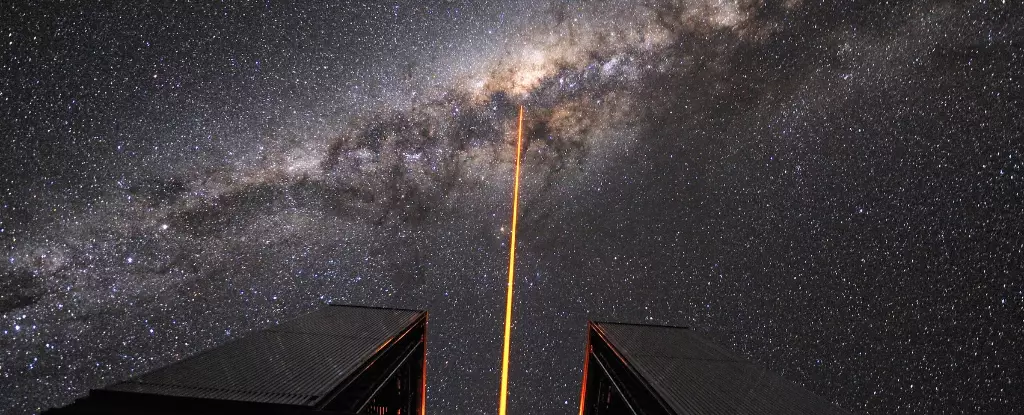At the heart of our galaxy, the Milky Way, lies a supermassive black hole known as Sagittarius A*. This astronomical wonder is not only a mysterious entity but also a significant player in the dynamics of our cosmic neighborhood. Spanning approximately 23.5 million kilometers in diameter and located around 27,000 light years from Earth, Sagittarius A* is a focal point for scientific exploration and intrigue. The recent discovery of a binary star system orbiting this black hole represents a monumental stride in our understanding of gravitational interactions and cosmic phenomena.
Binary star systems, where two stars orbit around a common center of mass, are essential to astronomers seeking insights into the universe. Our own Sun is a solitary star, not part of such a system, which contributes to the stability of our Solar System. It’s noteworthy that around two-thirds of stars in the Milky Way exist as solitary entities, leaving the remaining third as part of binary or multiple star configurations. Larger stars tend to exist in pairs due to their greater gravitational influence, making them ideal subjects for research.
The value of binarity lies in the wealth of data these systems provide. Through careful observation of their motions and behaviors, scientists can extract crucial information about the masses, ages, and evolutionary histories of the stars involved. Unlike solitary stars, whose mass is typically inferred from brightness, binary stars allow for more direct measurements through their orbital mechanics.
The recent discovery led by Florian Peißker and his team from the University of Cologne marks a historic achievement in astronomy. Despite the enormous distance and the inherent difficulties of observing such distant cosmic structures, the scientists were able to utilize the capabilities of the European Southern Observatory’s Very Large Telescope. By analyzing the Doppler effect, they detected subtle shifts in the starlight emanating from the system, indicating the presence of both stars and their orbital dynamics.
This technological triumph not only highlights the ingenuity of modern astronomy but also sheds light on the complex interactions at play near supermassive black holes. The ability to measure the distinct “wobble” of the stars has allowed researchers to confirm their existence and infer vital details about their origins and behavior in relation to Sagittarius A*.
In an exciting twist, the astronomers determined that the binary star system is approximately 2.7 million years old, suggesting that these stars ignited long before entering the gravitational influence of Sagittarius A*. The longevity of the stars in such a tumultuous environment—presumably a million years in their current path—offers profound implications about the stability and behavior of stars near supermassive black holes.
This information helps unravel the enigmatic nature of black holes, painting a clearer picture of their ability to trap and destabilize nearby celestial bodies. The phenomenon of hypervelocity stars—those traveling at extraordinary speeds beyond 1,000 kilometers per second—is thought to stem from gravitational interactions in similar environments, indicating the potential origins of these runaway stars.
The essence of gravitational dynamics near Sagittarius A* invites comparisons to familiar celestial systems, such as the Earth-Moon-Sun relationship. In orbital mechanics, stability often hinges on the relative distances between bodies; close pairs, like the Earth and Moon, interact primarily with one another, with external gravitational influences treated as secondary. However, if one body strays too close to a massive entity like a supermassive black hole, complex behaviors may unfold, leading to one component being ejected or altered extensively.
This complex ballet of interactions helps illuminate a theory regarding the formation of hypervelocity stars. Past binaries that drew too near to Sagittarius A* may have undergone tumultuous orbits, resulting in one star being flung away with tremendous velocity. The observational evidence hints that many hypervelocity stars are seen moving away from the center of the Milky Way, further corroborating the hypothesis of their ejected origins.
The discovery of a binary star system around Sagittarius A* embodies a pivotal moment in astronomical research. As scientists continue to investigate the dynamics of this and similar systems, they deepen our understanding of gravitational extremes and the behavior of stars in the proximity of black holes. Moreover, this finding enriches the context in which hypervelocity stars are studied, providing crucial insights into their origins and the overarching structure of our galaxy.
The area surrounding supermassive black holes like Sagittarius A* remains one of the most captivating realms in modern astronomy. As we piece together the cosmic puzzle, each discovery—like the elusive binary star system—brings us one step closer to unraveling the mysteries of our universe.


Leave a Reply